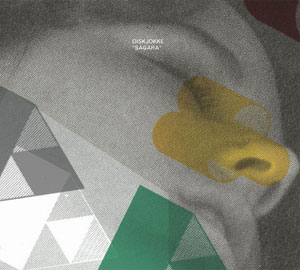
diskJokke
Sagara
(Smalltown Supersound; 2011)
By Conrad Amenta | 9 June 2011
I was, and still am, a big fan of Joachim Dyrdahl’s joyous, scattershot Staying In (2008), which collected previously-released material and sounded no worse for its patchwork nature. I thought it was one of the best albums of that year, and certainly a top five among dance records. He seemed paired, a little, with countryman Lindstrøm, though offering a distilled, condensed version of their shared acid textures and unapologetically earnest tone. Three years later, Staying In is still a fun album, as purposeful and invigorating as it ever was without seeming silly or disposable. It’s dance music by someone who seems to take dance music very seriously.
But because Staying In is precisely the compilation that it is, it wasn’t not so strange that follow-up albums En Fin Tid (2010) and now Sagara sound so different—coolly detached projects unto themselves, as if Dyrdahl is purposefully distancing himself from his house roots. Understandable from a creative perspective; the genre that Staying In made its touch point is so structurally set in its ways, offers a fully mapped-out formula for what to do next and how, that it’s hardly surprising someone with a kind of skill set like Dyrdahl’s would tire of it. Add to that the long history of unwanted reinvention foisted upon dance music from the outside—culminating in clumsy attempts by the majors to turn Prodigy and Moby into the Next Big Thing after grunge—and it makes sense that the Scandinavians have taken it on themselves to reinvent house without necessarily blowing it up or inflating what’s there. To instead subtly shift its fundamental elements in dynamic or scope. Lindstrøm and the Studio and diskJokke have infused some of those same touchstones with ambient fuzz and long-form noodling. This seems like a worthy endeavor.
And so the fairest, if not the most favorable, thing that I can say about efforts like Sagara is that they are one worthwhile and necessarily incomplete part of a larger discussion. After all, it’s right there in the album’s thesis statement: “[Dyrdahl] decided to focus on the traditional Indonesian music known as Gamelan. From there, he contacted a group called Sambasunda from Bandung, Java in Indonesia. diskJokke spent two weeks in their studio recording traditional instruments and sounds, as well as venturing outside the studio to capture city noise and mountain springs. The original intent was to make this into a dance project, maybe even leaning more towards techno, as he felt Gamelan and techno share a similar aesthetic in some regards.” This sort of exploration—which is to say, exploration without truly leaving one’s aesthetic playpen—is important to a genre, though it’s not apparent from any of these tracks what bridge diskJokke has built between the dance music for which he’s known and Indonesian Gamelan. For a genre which samples and absorbs, diskJokke has continued to subsume into itself rather than allow itself to be subsumed. There are no new truths revealed about either end of this binary, but to expect as much is probably unreasonable. It’s a long process, and it should be difficult. Those who go first fail on behalf of the rest of us.
So Sagara sounds necessarily and unavoidably at odds with itself, a not wholly successful balancing act that lands its objects within sight and some distance from where its artist intended, but the effort is commendable and important. I’ve written at length about how significant ambient music’s post-Millennial renaissance may one day be considered by those of us who use music to take the temperature of its listeners; house music’s reinvention, still (somehow) in its infancy, and here essentially moving toward ambient altogether, may too find itself spoken about this way, and if it does diskJokke will be a part of that conversation.





